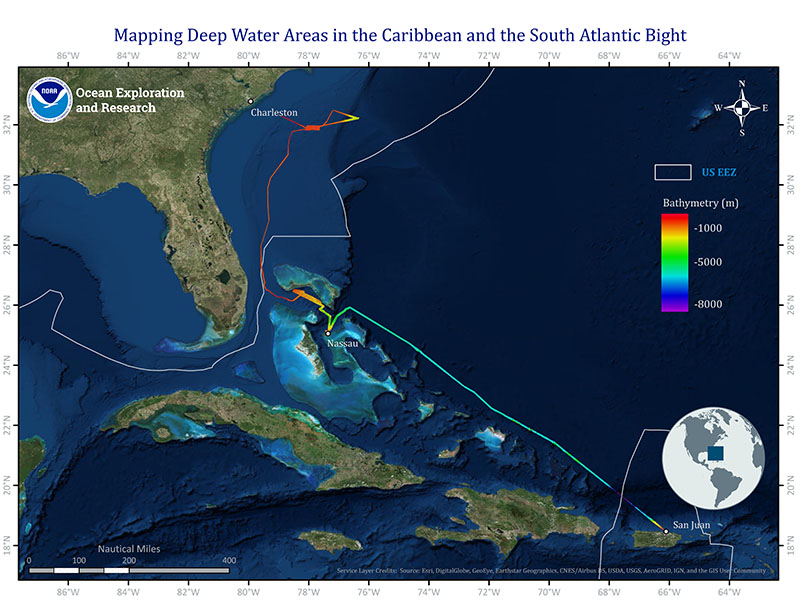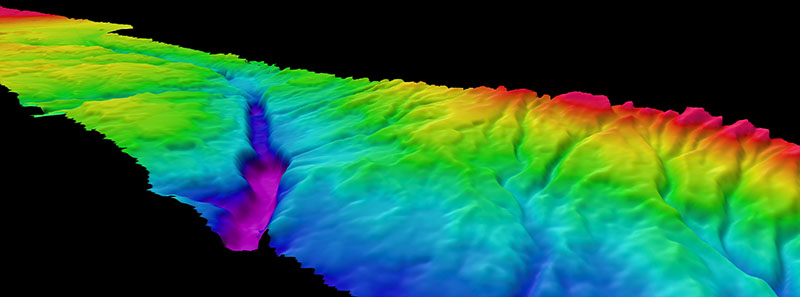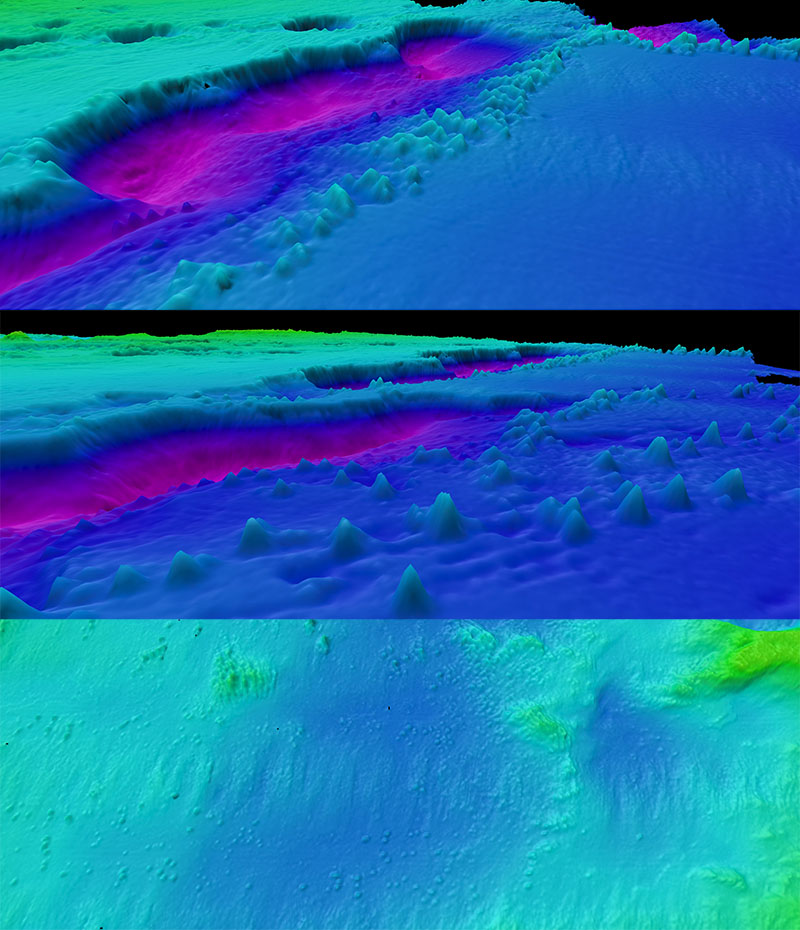
NOAA Ship Okeanos Explorer
November 28 - December 14, 2018
Mapping Deepwater Areas in the Caribbean and South Atlantic Bight was one of several expeditions the NOAA Office of Ocean Exploration and Research (OER) conducted in 2018 as part of the Atlantic Seafloor Partnership for Integrated Research and Exploration (ASPIRE) campaign, a major multi-year, multi-national collaborative field program focused on raising collective knowledge and understanding of the North Atlantic Ocean.

Overview map showing the locations of mapping operations completed during the Mapping Deepwater Areas in the Caribbean and South Atlantic Bight expedition. Map created by the NOAA Office of Ocean Exploration and Research. Download larger version (jpg, 13.8 MB).
Mapping Deepwater Areas in the Caribbean and South Atlantic Bight was a 17-day telepresence-enabled expedition aboard NOAA Ship Okeanos Explorer to collect critical information and acquire data on priority exploration areas identified by the ocean management and scientific communities and test innovative new technologies. This expedition involved exploration of a diversity of deepwater features using mapping and remotely operated vehicle (ROV) operations in the Atlantic Ocean from San Juan, Puerto Rico, to Charleston, South Carolina. The team completed a strategic transit to target unmapped deep-sea features from Puerto Rico to the Bahamas. During this expedition, NOAA partnered with the University of Rhode Island, the University of New Hampshire (UNH) Center for Coastal and Ocean Mapping (CCOM), JASCO Applied Sciences, and the U.S. Navy Undersea Warfare Center. Highlights from the expedition are summarized below. Download a PDF version of this summary (pdf, 1.6 MB).

This 2,600 meter (8,350 foot) seamount was mapped during a strategically planned transit from Puerto Rico to the Bahamas and discovered to be nearly 800 meters (2,625 feet) shallower than predicted by the satellite bathymetry. The bathymetry collected during the expedition (in rainbow) overlays the Global Multi-Resolution Topography grid. Image courtesy of the NOAA Office of Ocean Exploration and Research, Mapping Deepwater Areas in the Caribbean and South Atlantic Bight. Download larger version (jpg, 1.1 MB).

NOAA Ship Okeanos Explorer maximized its time leeward of the Grand Bahama Island while taking refuge from unfavorable weather conditions. In total, 1,700 square kilometers (656 square miles) of this area were mapped, including this meandering canyon feature. Image courtesy of the NOAA Office of Ocean Exploration and Research, Mapping Deepwater Areas in the Caribbean and South Atlantic Bight. Download larger version (jpg, 3 MB).

NOAA Ship Okeanos Explorer mapped 800 square kilometers (309 square miles) of unmapped seafloor in this ASPIRE priority area. This was identified by scientists and community partners about a month prior to the expedition at the NOAA OER-hosted ASPIRE Science Planning workshop. Image courtesy of the NOAA Office of Ocean Exploration and Research, Mapping Deepwater Areas in the Caribbean and South Atlantic Bight. Download larger version (jpg, 3.7 MB).

Numerous mounded structures were discovered, both lining basins on the eastward side of the ASPIRE priority area and sporadically throughout the area. These structures range from 5 - 30 meters (16 - 98 feet) high and are likely deep-sea coral mounds, as similar features were discovered during previous expeditions in nearby locations. Image courtesy of the NOAA Office of Ocean Exploration and Research, Mapping Deepwater Areas in the Caribbean and South Atlantic Bight. Download larger version (jpg, 15.1 MB).

These pressure chambers were printed at sea by the URI team using their 3D printer. They were sent to a depth of 200 meters (656 feet) and successfully recovered intact, without any leaks or structure failures. To the team's knowledge, this is the first documented time this type of device has been printed at sea and then tested at depth. Image courtesy of the NOAA Office of Ocean Exploration and Research, Mapping Deepwater Areas in the Caribbean and South Atlantic Bight. Download larger version (jpg, 3.3 MB).
Data collected during this expedition will inform initial characterization of the areas visited and includes multibeam, single beam, sub-bottom, ADCP, XBT, CTD, and dissolved oxygen profiles and data from surface oceanographic and meteorological sensors. All data from this expedition will be publicly available through national archives. OceanExplorer.NOAA.gov will provide a direct link to the expedition data archive once available.